I’m just going to give up on apologizing for how time gets away from me. The last week of January was rather busy, and this week I have been on vacation but catching up on a variety of things. I will be devoting some time in the next few days to the blog, and have a fair bit to natter about, so watch for those posts.
But today I’m writing about my most recent cooking forays, beef stew from Mark Bittman’s How to Cook Everything and chicken soup whose recipe I made up as I went along. (I also roasted a chicken on Sunday night, using guidance from Bittman as well, but my camera battery died early on and I didn’t think a photo of the raw bird would be very encouraging without the contrast of the beautifully roasted finished version. So I’ll pass over that.)
The steps for beef stew were fairly simple. You start with some diced beef (I used rump roast).
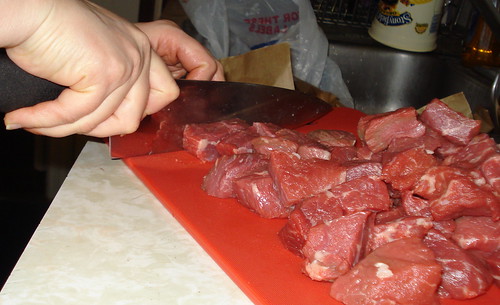
Brown it in some oil in which you have previously browned a clove of garlic, then remove the cubes from the pot and brown some onions in the leftover fat (pouring off excess).
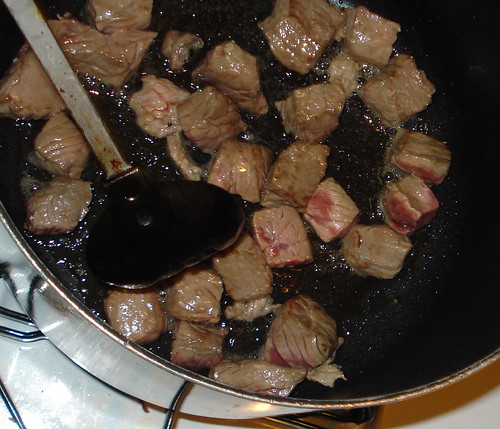
You add some flour to the onions and cook briefly to brown a bit, which helps start a roux, then add the beef back in along with some liquid, thyme and a bay leaf.
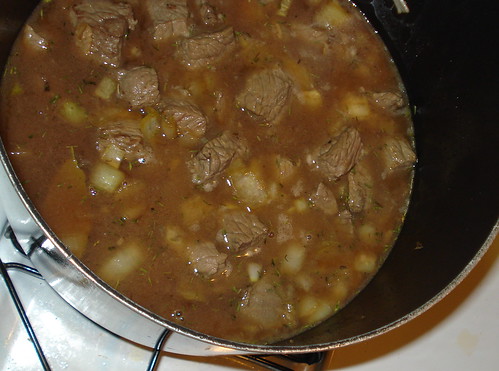
You let that simmer for about half an hour, during which time you cut up some potatoes (I used red) and carrots. You’re also supposed to add peas toward the end, but I didn’t have any, so at this stage I also sliced some mushrooms and added them after the half hour was up. You add those and let cook for about another half hour to an hour, or until the potatoes are tender; then you add some garlic (and the peas if you had read the recipe before shopping, unlike me) and cook for about another five minutes, simmering if you’re satisfied with the thickness of the liquid, boiling if you want it to thicken a bit. And voila, tasty goodness.

I also wanted a green vegetable on the side, so I decided to roast some Brussels sprouts. You cut off the ends and cut the sprouts in half–quarters if you have any unusually large ones in the bunch.
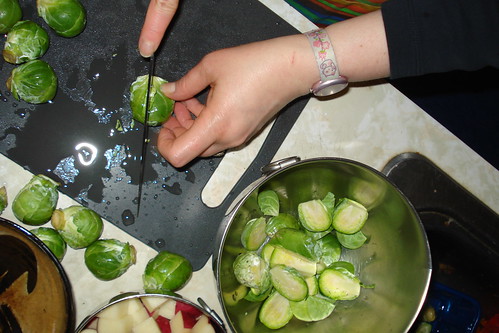
Then you toss them with a bit of olive oil and season with kosher salt and freshly ground pepper, then roast in a 400 degree oven for about 40 minutes, tossing periodically for even cooking.
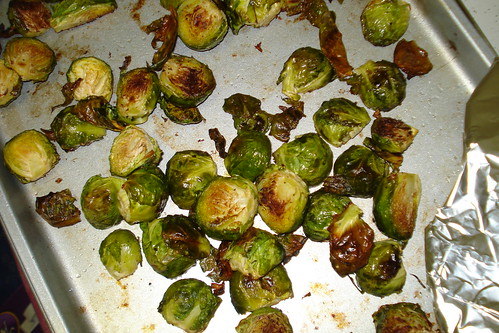
The roasting helps mellow the pungent flavor, and ensures a much better texture than steaming (at least in my experience).
That was Monday night; beef stew seemed like a good meal for the weather, which was in the 40s–not as cold as some days we have seen this season. Yesterday, by constrast, was snowy and getting colder, and I decided that chicken soup was the right meal for the evening. I don’t think I’ve ever made the same chicken soup twice; I always improvise it.

First I get together the ingredients I plan to use–in this case, chicken thigh meat, chopped onions, garlic, bell peppers, celery, carrots, potatoes, yellow squash, mushrooms, parsnips, some canned chickpeas, and some spices.
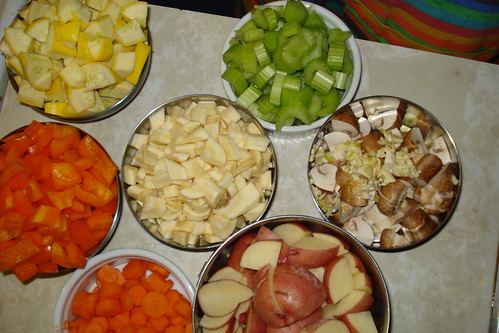
I start by browning the chicken, then adding the onions. At this point the food is thick enough in the pan that I’m not so much sauteeing as sweating, but that’s OK.
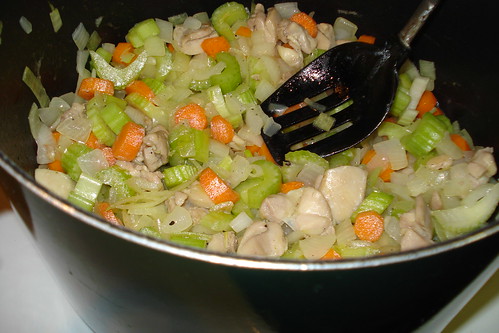
I add the ingredients bit by bit, saving out the bell peppers; when I’ve added all the fresh ingredients I add the chickpeas (either including the liquid or draining it off, depending on the brand), and broth to cover plus a little extra, and bring it all to a boil, then lower to a simmer and let it cook. After about 15 minutes I add the bell peppers, then let it cook for a while. When it’s about 12 minutes until I want to serve up, I bring it back to a boil and add about half or three-quarters of a cup of dried mini pasta, in this case ditalini (little tubes). Alphabets or stars are fun too. I let that boil for about 10 minutes, then fish out the bay leaf if I included one and announce that supper is ready.
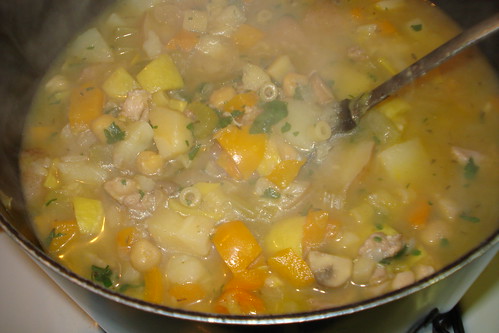
Last night I also wanted to make a cookie, so while I was shopping for vegetables I made sure to get chocolate chunks, butter and flour. You can imagine my surprise when, after I had creamed the butter, I discovered that I was out of both regular granulated sugar and brown sugar. The snow was falling fast outside and the flour had been mixed with baking soda and salt; what to do? I rummaged the shelves and found some superfine sugar and some molasses, and I improvised quantities. I had less of the superfine sugar than I had hoped, so I had to use quite a bit of molasses; to keep its flavor from totally overwhelming the chocolate I added a splash of milk and some extra almond extract (we were out of vanilla too, much to my indignation). I also added more flour until I was satisfied that the consistency was similar enough to my usual chocolate chip cookie dough, then stirred in some pecan bits to help tie the flavors together, and the chocolate chunks. I spread the dough flat in a rimmed baking sheet and baked it at 350 for about 15 minutes.
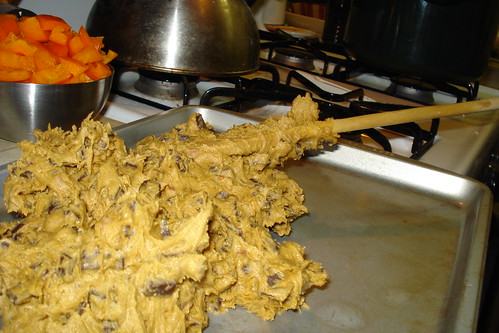
Then I let it cool before cutting into bars.
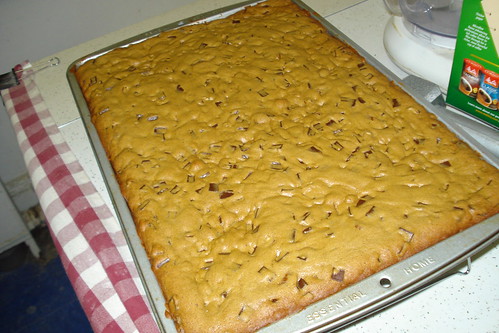
They turned out tasty; I felt the molasses flavor was still stronger than I liked, but my husband thought they were delicious and rich. They’d go nicely with milk, or with ice cream. I’ll have to experiment again with a different balance of molasses and sugar; with a bit less bite from the molasses and a more pronounced nut flavor this could really be a keeper. Not bad for a panicky improvisation.
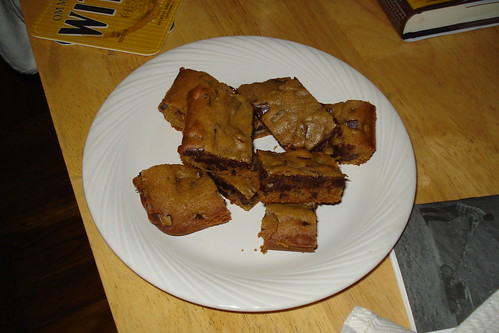
One final note: Many of the photos in this post were made possible with the help of the tripod that my husband gave me as a surprise gift earlier this month. The legs are bendable, so you can hook them on cabinet handles and shelf rims to get better angles. That plus the 10-second timer helped me get photos of actual cutting or cooking maneuvers that required both hands, relieving me of the need to learn to operate the camera with my teeth.
Due to my previous life in financial aid I have a lot of post-it notes (with notes on them from lenders like “We help students [go into debt!!”]). I keep one on the fridge for the ongoing grocery list, and add things I don’t look at daily (read: baking ingredients and cleaning products) as I pour out the last of whatever. It’s the most organized thing related to food that I do at home. Working at a food bank I organize a lot of food away from home so at home it’s catch as catch can.